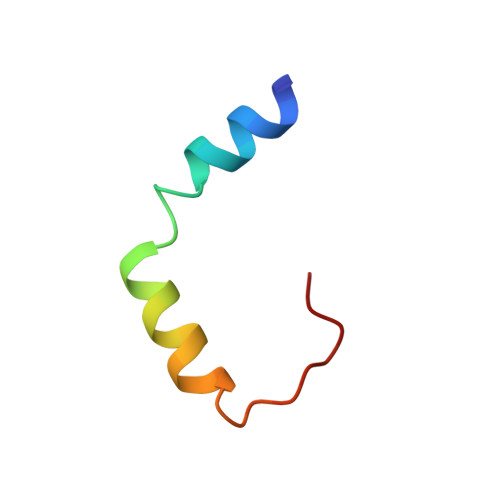Cleavage of mitochondrial homeostasis regulator PGAM5 by the intramembrane protease PARL is governed by transmembrane helix dynamics and oligomeric state.
Siebert, V., Silber, M., Heuten, E., Muhle-Goll, C., Lemberg, M.K.(2022) J Biol Chem 298: 102321-102321
- PubMed: 35921890
- DOI: https://doi.org/10.1016/j.jbc.2022.102321
- Primary Citation of Related Structures:
7QAL, 7QAM, 7QAO, 7QAP - PubMed Abstract:
The intramembrane protease PARL acts as a crucial mitochondrial safeguard by cleaving the mitophagy regulators PINK1 and PGAM5. Depending on the stress level, PGAM5 can either stimulate cell survival or cell death. In contrast to PINK1, which is constantly cleaved in healthy mitochondria and only active when the inner mitochondrial membrane is depolarized, PGAM5 processing is inversely regulated. However, determinants of PGAM5 that indicate it as a conditional substrate for PARL have not been rigorously investigated, and it is unclear how uncoupling the mitochondrial membrane potential affects its processing compared to that of PINK1. Here, we show that several polar transmembrane residues in PGAM5 distant from the cleavage site serve as determinants for its PARL-catalyzed cleavage. Our NMR analysis indicates that a short N-terminal amphipathic helix, followed by a kink and a C-terminal transmembrane helix harboring the scissile peptide bond are key for a productive interaction with PARL. Furthermore, we also show that PGAM5 is stably inserted into the inner mitochondrial membrane until uncoupling the membrane potential triggers its disassembly into monomers, which are then cleaved by PARL. In conclusion, we propose a model in which PGAM5 is slowly processed by PARL-catalyzed cleavage that is influenced by multiple hierarchical substrate features, including a membrane potential-dependent oligomeric switch.
Organizational Affiliation:
Center for Molecular Biology of Heidelberg University (ZMBH), Heidelberg, Germany; Center for Biochemistry and Cologne Excellence Cluster on Cellular Stress Responses in Aging-Associated Diseases (CECAD), Medical Faculty, University of Cologne, Cologne, Germany.














